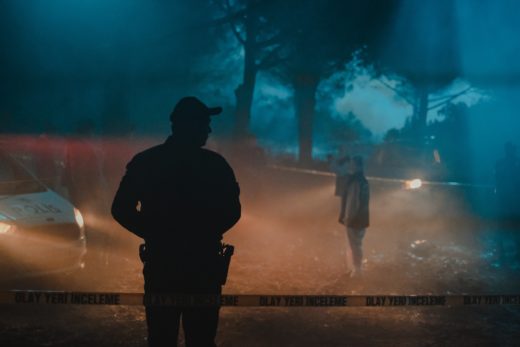
Something we sometimes have to accept in modern television is characters who
have agreed to ignore the fact that something nearby appears to be on fire. Still, haze is very pretty if we fire beams of light through it, and it’s an effect we can just as easily recreate on a per-room scale with a low-cost disco fogger and a desk fan. Mist and fog are low-cost options, and therefore tempting additions to our low-effort cinematography toolkit.
The mist of ages
It’s easiest to justify in a period setting, where practical light sources required fire and smoking was common. It’s less reasonable in the modern world, not that it stops anyone. The archetypal image of a cinema auditorium with the projector’s beam lancing through the space is one that hasn’t really existed for decades, given almost universal ban on smoking indoors. Even if we’re shooting a period scene, though, the sort of dense haze we sometimes encounter suggests that someone has been failing to trim lamp wicks and buying the very cheapest candles made out of the least-edible bits of rendered-down cow.
There is a point at which even the most permissive Jane Austen character would have stopped coughing long enough to complain that there’s something in the air, but no matter – it’s cinema, and in 2021 we can create that effect without clogging anyone’s lungs with soot. So, embrace the hyper-reality, because mist does two good things: it provides us the sort of depth-sensitive contrast reduction and diffusion that flat filters can’t, and in conjunction with appropriate camera movement and lighting (particularly, see our cheat’s manifesto on backlight) it adds dimension to mere air in a way that works to stretch the limits of our largely two-dimensional artform.
The first of those things – diffusion and depth – is the least obviously showy, and best if it’s done with a lot of understatement. It’s surprisingly difficult to generate an ultra-subtle haze in the air of even quite a small room and keep it consistent between takes, and easy to inadvertently create continuity problems as the haze dissipates. These problems can be quite hard to solve. The whole reason we’re using haze rather than a filter is because the haze gets denser the further away it is, something that’s difficult to match in Resolve. The ideal density can also change wildly depending on the camera position. A fixed density looks denser in more distant setups, something that might logically be right, but doesn’t always look right.
Once we’ve established that gentle-but-consistent degree of mist, the other thing we can do is fire light beams through it. Beams of light have perspective behaviour just like any other three-dimensional phenomenon, but they can accentuate vast spaces in a way that doesn’t require the production to build huge set pieces. The sheer scale is helpful, as is the ability to move the camera through them. The other option is to move the light, although there’s an originality trap – Blade Runner made such good use of theatrical followspots that lancing beams for their own sake are hard to justify, with a cautious hall pass for the guard tower searchlights in prison camp escape scenes.
A light touch
A subtle-but-visible haze can be achieved in a few ways. The average disco fogger is a perfectly functional approach and can be directed through a desk fan to blast it into the sort of diffuse effect we’re after. Lacking the desk fan – which is noisy, of course – we need someone with a piece of folded cardboard to beat the dense cloud of fog into a less dense and cloudy state. There are purpose-built hazers, although there’s often a need for an attendant anyway, to watch the overall level and keep it consistent. There are automated systems, but this is coarse cinematography, and there are probably better places to allocate funds.
Finally, a word on safety. Notice we haven’t used the word “smoke,” because smoke is a product of things burning, and if a fog machine is burning the fluid there’s something wrong with it. The most common foggers, the inexpensive type that’s available everywhere, operates by vapourising, not burning, a combination of water and some sort of glycol, and there’s even some speculation that the resulting steam actually has a mild antimicrobial effect that can be helpful against airborne diseases just such as coronavirus.
Happily, it’s harmless in normal concentrations, as every night club, theatre and vape enthusiast can attest, so long as the machine is operating correctly. If it’s too hot, it can burn the oil, so don’t use a machine that’s damaged, ancient or malfunctioning. If it’s too cool it can spit hot liquid glycol solution, which they often do to at least a small degree. Perhaps the biggest risk is ruining someone’s carpet, so put it on a couple of layers of tarp and aim it into a bucket to catch the spray. Some locations are sniffy about fog, often for these reasons. Other technologies have different concerns, so consult the supplier.
There’s an argument that this crosses over into special or physical effects. That argument is usually made by people on productions where the physical effects department has its own gleaming, chrome-wheeled truck and a union contract. Filmmaking is a team sport, though, and hiding the financial limitations of other departments behind a vague wall of depthless mist can be, well, team-building.
